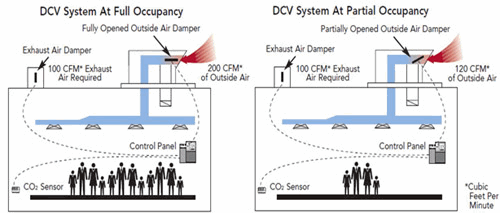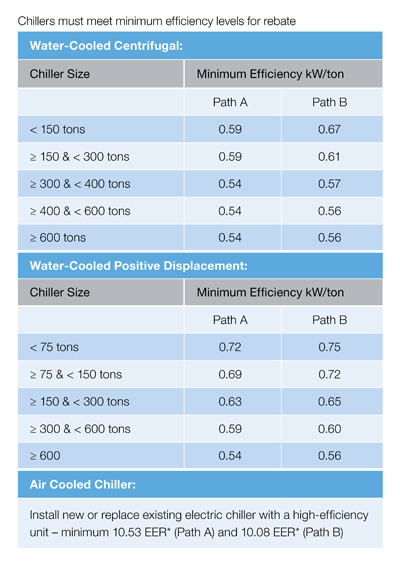Did you know that heating and cooling alone can use 50% of the energy in commercial buildings?
Our Business HVAC Program can help. We offer energy-saving solutions that can make a real difference to your organization.
Plus, you may qualify for rebates and tax deductions to help with the upfront investment costs.
Explore our systems
Chiller
Get an average rebate of $3,000* per project while balancing energy savings and a comfortable environment. Our program helps your business manage energy expenses effectively, ensuring optimal comfort for employees, customers and equipment
There are two types of chillers: air-cooled and water-cooled which simply describes how the chillers’ condenser is removing heat from the building.
Chillers are refrigeration systems that produce and circulate chilled water to air-handler units. Inside the air-handler units, fans push air across the evaporator coils to cool and dehumidify air.
They are typically found in larger commercial/industrial facilities with combined loads of 100 tons or more.
Related resources
Direct-Expansion Air Conditioning
Receive an average rebate of $700* per project when upgrading to more efficient cooling systems. Air conditioning costs typically account for 50% of a business's energy bill, but newer systems can help offset these expenses.
Demand control ventilation and energy recovery ventilation can also be installed within your direct-expansion (DX) A/C system for even more savings.
See if you qualify by contacting a program specialist.
DX A/C is just a technical term for a standard air conditioner or commercial HVAC system including split systems, mini splits, packaged type units and rooftop units.
The inside air-handler unit uses a fan to push air across the evaporator coil, which absorbs heat to cool and dehumidify air. It works with the outdoor condenser unit to release the heat from the freon to the outside so it can return and absorb more heat.
- Air, water and evaporative-cooled A/Cs and heat pumps
- Single vertical package A/Cs and heat pumps
- Variable refrigerant flow A/C sand heat pumps, both air-cooled and water-cooled
- Computer Room cooling systems- air, water, and glycol cooled
- Package terminal A/Cs or heat pump systems
- Units that exceed the Florida Building Code
Visit the U.S. Department of Energy's website for a calculator that computes the lifetime energy cost savings for rooftop units.
Related resources
Demand Control Ventilation
Demand control ventilation (DCV) can save your organization as much as 25% per year on HVAC energy costs. Gain a competitive advantage with higher energy-efficiency and get rebates up to $500 for each sensor installed.
Most HVAC systems are designed to supply outside air based on maximum building occupancy, rather than actual occupancy to meet building codes.
DCVs modulates the amount of outside air supplied to a building based on actual occupancy, saving energy and improving humidity control.
While benefits vary depending on climate, areas with hot, humid summers like Florida are ideal for DCV systems.

- Each CO2 sensor must be installed and connected to qualify
- Your DCV must reduce outside air flow at low occupancy and modulate outside air flow based on real-time sensor readings
- Businesses with long operating hours that have unpredictable or varied occupancy benefit the most from this technology, as well as businesses that rarely reach maximum occupancy
Related resources
Energy Recovery Ventilation
Receive an average rebate of over $5,000* when you install an energy recovery ventilation (ERV) system and reduce your cooling load up to 20%. An ERV system works with your HVAC system to prevent energy waste and cool fresh air as it enters your building.
An ERV recovers energy from building exhaust air and reuses it to precondition fresh, outside air required for ventilation.
In a hot and humid climate like ours, the cooler, drier building exhaust air can be used to pre-treat and pre-cool incoming air so your air conditioner doesn't have to work as hard.
In the winter months, exhaust air can be used to pre-heat incoming air, helping you save on your heating costs.
The energy transfer is at a molecular level, humidity stays in a vapor state, meaning no liquid condensation is produced.
A stand-alone ERV system serves a rooftop air-conditioning unit located nearby and exhaust air from spaces that need to be ventilated anyway - including restrooms, offices and break rooms.
The ERV system replaces an existing exhaust fan and enables most or all of exhaust to be used for recovery.

A bolt-on ERV system is built into a rooftop air-conditioning unit and enables more than 50% of the total ventilated exhaust to be used for recovery.
Because the bolt-on ERV system draws exhaust from the return duct only, an exhaust fan is still required for spaces like restrooms, offices, and break rooms.

Related resources
Kitchen Demand Control Ventilation
Benefit from an average rebate of $7,500* when you install a qualifying kitchen demand control ventilation (KDCV) system or add to an existing exhaust fan – plus reduce up to 50% per year on ventilation costs.
A KDCV system saves energy by controlling exhaust hood air flow and fan speed depending on the level of cooking activity. The sensors adjust exhaust fan speeds based on changes in temperature and the amount of smoke present.
Kitchen exhaust hoods prevent fires by removing the heat and smoke generated by cooking. Yet, most systems consume extra energy by operating at full capacity even when cooking appliances are idle.
Related resources
Get pre-approved
If you’re interested in installing new HVAC systems or upgrading existing, please complete the form and a program specialist will reach out to you.
When you upgrade your indoor lighting and HVAC systems to improve energy efficiency, your business may qualify for federal tax credits administered by the IRS.
*Note: The rebate amounts depend on the size of the installation per project.
